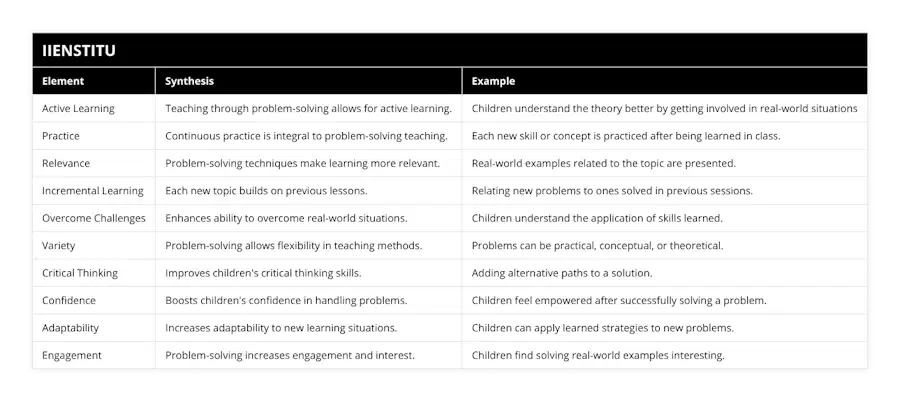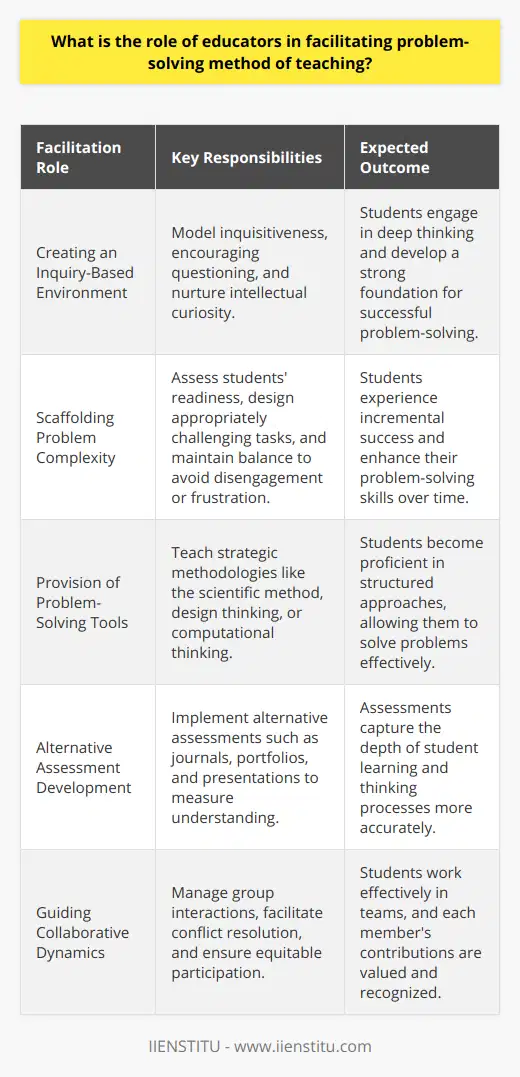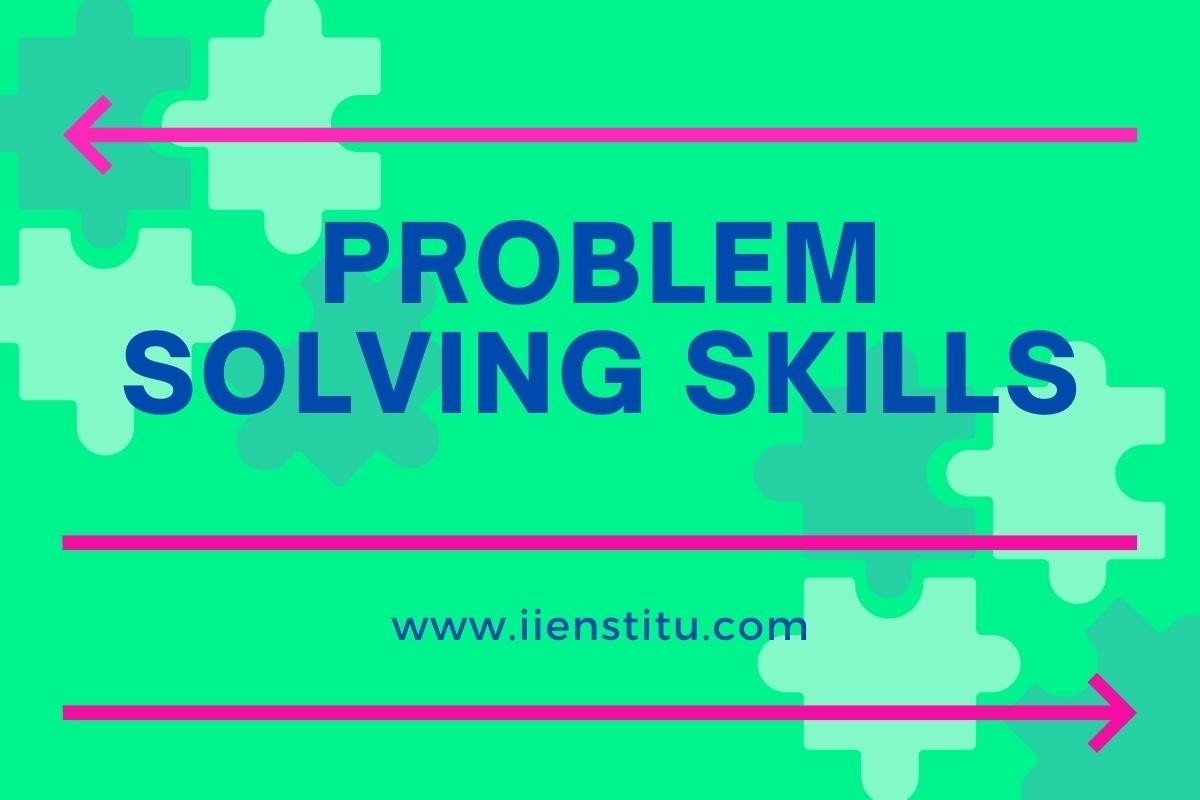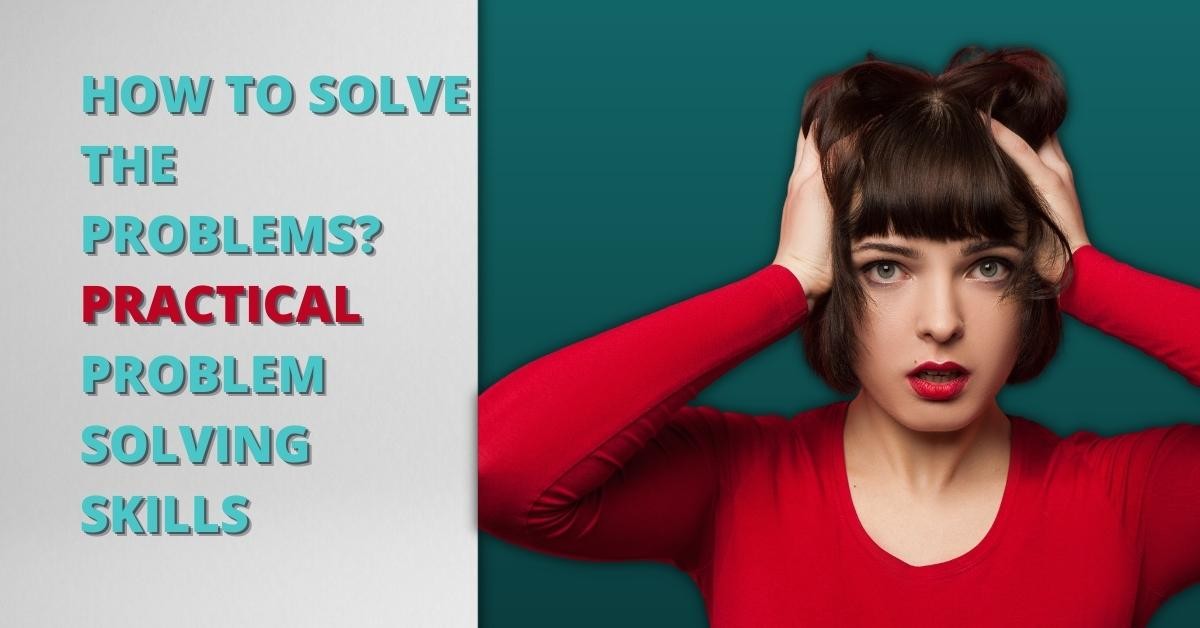
The problem-solving method of teaching is the learning method that allows children to learn by doing. This is because they are given examples and real-world situations so that the theory behind it can be understood better, as well as practice with each new concept or skill taught on top of what was previously learned in class before moving onto another topic at hand.
What is your preferred problem-solving technique?
Answers:
I like to brainstorm and see what works for me
I enjoy the trial and error method
I am a linear thinker
Share it with me by commenting.
For example, while solving a problem, the child may encounter terms he has not studied yet. These will further help him understand their use in context while developing his vocabulary. At the same time, being able to practice math concepts by tapping into daily activities helps an individual retain these skills better.
One way this type of teaching is applied for younger students particularly is through games played during lessons. By allowing them to become comfortable with the concepts taught through these games, they can put their knowledge into use later on. This is done by developing thinking processes that precede an action or behavior. These games can be used by teachers for different subjects including science and language.
For younger students still, the method of teaching using real-life examples helps them understand better. Through this, it becomes easier for them to relate what they learned in school with terms used outside of school settings so that the information sticks better than if all they were given were theoretical definitions. For instance, instead of just studying photosynthesis as part of biology lessons, children are asked to imagine plants growing inside a dark room because there is no sunlight present. When questioned about the plants, children will be able to recall photosynthesis more easily because they were able to see its importance in real life.
Despite being given specific examples, the act of solving problems helps students think for themselves. They learn how to approach situations and predict outcomes based on what they already know about concepts or ideas taught in class including the use of various skills they have acquired over time. These include problem-solving strategies like using drawings when describing a solution or asking advice if they are stuck to unlock solutions that would otherwise go beyond their reach.
Comprehensive Guide To Strategized Initiatives And Expert Tactics
Mastering The 5 Whys Technique For Profound Problem-solving İnsights
Teachers need to point out in advance which method will be used for any particular lesson before having children engage with it. By doing this, individuals can prepare themselves mentally for what is to come. This is especially true for students who have difficulty with a particular subject. In these cases, the teacher can help them get started by providing a worked example for reference or breaking the problem down into manageable chunks that are easier to digest.
JIT (Just-in-Time): A Comprehensive Examination of its Strategic Impact
Root Cause Tree Analysis: Insights to Forensic Decision Making
Hazard Analysis: A Comprehensive Approach for Risk Evaluation
Ultimately, the goal of teaching using a problem-solving method is to give children the opportunity to think for themselves and to be able to do so in different contexts. Doing this helps foster independent learners who can utilize the skills they acquired in school for future endeavors.
The problem-solving method of teaching allows children to learn by doing. This is because they are given examples and real-world situations so that the theory behind it can be understood better, as practice with each new concept or skill taught on top of what was previously learned in class before moving onto another topic at hand.
For example, while solving a problem, the child may encounter terms he has not studied yet. These will further help him understand their use in context while developing his vocabulary. At the same time, being able to practice math concepts by tapping into daily activities helps an individual retain these skills better.
One way this type of teaching is applied for younger students particularly is through games played during lessons. By allowing them to become comfortable with the concepts taught through these games, they are able to put their knowledge into use later on. This is done by developing thinking processes that precede an action or behavior. These games can be used by teachers for different subjects including science and language.
For instance, a teacher may ask students to imagine they are plants in a dark room because there is no sunlight present. When questioned about the plants, children will be able to recall photosynthesis more easily because they were able to see its importance in real life.
Despite being given specific examples, the act of solving problems helps students think for themselves. They learn how to approach situations and predict outcomes based on what they already know about concepts or ideas taught in class including the use of various skills they have acquired over time. These include problem-solving strategies like using drawings when describing a solution or asking advice if they are stuck to unlock solutions that would otherwise go beyond their reach.
It is important for teachers to point out in advance which method will be used for any particular lesson before having children engage with it. By doing this, individuals can prepare themselves mentally for what is to come. This is especially true for students who have difficulty with a particular subject. In these cases, the teacher can help them get started by providing a worked example for reference or breaking the problem down into manageable chunks that are easier to digest.
Ultimately, the goal of teaching using a problem-solving method is to give children the opportunity to think for themselves and to be able to do so in different contexts. Doing this helps foster independent learners who can utilize the skills they acquired in school for future endeavors.
lesson before having children engage with it. By doing this, individuals can prepare themselves mentally for what is to come. This is especially true for students who have difficulty with a particular subject. In these cases, the teacher can help them get started by providing a worked example for reference or breaking the problem down into manageable chunks that are easier to digest.
Ultimately, the goal of teaching using a problem-solving method is to give children the opportunity to think for themselves and to be able to do so in different contexts. Doing this helps foster independent learners who can utilize the skills they acquired in school for future endeavors.
The teacher should have a few different ways to solve the problem.
For example, the teacher can provide a worked example for reference or break down the problem into chunks that are easier to digest.
The goal of teaching using a problem-solving method is to give children the opportunity to think for themselves and to be able to do so in different contexts. Successful problem solving allows children to become comfortable with concepts taught through games that develop thinking processes that precede an action or behavior.
Introduce the problem
The problem solving method of teaching is a popular approach to learning that allows students to understand new concepts by doing. This approach provides students with examples and real-world situations, so they can see how the theory behind a concept or skill works in practice. In addition, students are given practice with each new concept or skill taught, before moving on to the next topic. This helps them learn and retain the information better.
Explain why the problem solving method of teaching is effective.
The problem solving method of teaching is effective because it allows students to learn by doing. This means they can see how the theory behind a concept or skill works in practice, which helps them understand and remember the information better. This would not be possible if they are only told about the new concept or skill, or read a textbook to learn on their own. Since students can see how the theory works in practice through examples and real-world situations, the information is easier for them to understand.
List some advantages of using the problem solving method of teaching.
Some advantages of using the problem solving method of teaching are that it helps students retain information better since they are able to practice with each new concept or skill taught until they master it before moving on to another topic. This also allows them to learn by doing so they will have hands-on experience with facts which helps them remember important facts faster rather than just hearing about it or reading about it on their own. Furthermore, this teaching method is beneficial for students of all ages and can be adapted to different subjects making it an approach that is versatile and easily used in a classroom setting. Lastly, the problem solving method of teaching presents new information in a way that is easy to understand so students are not overwhelmed with complex material.
The problem solving method of teaching is an effective way for students to learn new concepts and skills. By providing them with examples and real-world situations, they can see how the theory behind a concept or skill works in practice. In addition, students are given practice with each new concept or skill taught, before moving on to the next topic. This them learn and retain the information better.
Questions
What has been your experience with adopting a problem-solving teaching method?
How do you feel the usefulness of your lesson plans changed since adopting this method?
What was one of your most successful attempts in using this technique to teach students, and why do you believe it was so successful?
Were there any obstacles when trying to incorporate this technique into your class?
Did it take a while for all students to get used to the new type of teaching style before they felt comfortable enough to participate in discussions and ask questions about their newly acquired knowledge?
What are your thoughts on this method?
“I have had the opportunity to work in several districts, including one where they used problem solving for all subjects. I never looked back after that experience--it was exciting and motivating for students and teachers alike."
"The problem solving method of teaching is great because it makes my subject matter more interesting with hands-on activities."

Frequently Asked Questions
What is the role of educators in facilitating problem-solving method of teaching?
Role of Educators in Facilitating Problem-Solving
Understanding the Problem-Solving Method
The problem-solving method of teaching encourages students to actively engage their critical thinking skills to analyze and seek solutions to real-world problems. As such, educators play a crucial part in facilitating this learning style to ensure the effective attainment of desired skills.
Encouraging Collaboration and Communication
One of the ways educators can facilitate problem-solving is by promoting collaboration and communication among students. Working as a team allows students to share diverse perspectives while considering multiple solutions, thereby fostering an open-minded and inclusive environment that is crucial for effective problem-solving.
Creating a Safe Space for Failure
Educators must recognize that failure is an integral component of the learning process in a problem-solving method. By establishing a safe environment that allows students to fail without facing judgment or embarrassment, teachers enable students to develop perseverance, resilience, and an enhanced ability to learn from mistakes.
Designing Relevant and Engaging Problems
The selection and design of appropriate problems contribute significantly to the success of the problem-solving method of teaching. Educators should focus on presenting issues that are relevant, engaging, and age-appropriate, thereby sparking curiosity and interest amongst students, which further improves their problem-solving abilities.
Scaffolding Learning
Scaffolding is essential in the problem-solving method for providing adequate support when required. Teachers need to break down complex problems into smaller, manageable steps, and gradually remove support as students develop the necessary skills, thus promoting their self-reliance and independent thinking.
Providing Constructive Feedback
Constructive feedback from educators is invaluable in facilitating the problem-solving method of teaching, as it enables students to reflect on their progress, recognize areas for improvement, and actively develop their critical thinking and problem-solving abilities.
In conclusion, the role of educators in facilitating the problem-solving method of teaching comprises promoting collaboration, creating a safe space for failure, designing relevant problems, scaffolding learning, and providing constructive feedback. By integrating these elements, educators can help students develop essential life-long skills and effectively navigate the complex world they will experience.

Can interdisciplinary approaches be incorporated into problem-solving teaching methods, and if so, how?
Interdisciplinary Approaches in Problem-Solving Teaching Methods
Integration of Interdisciplinary Approaches
Incorporating interdisciplinary approaches into problem-solving teaching methods can be achieved by integrating various subject areas when presenting complex problems that require students to draw from different fields of knowledge. By doing so, learners will develop a deeper understanding of the interconnectedness of various disciplines and improve their problem-solving skills.
Project-Based Learning Activities
Implementing project-based learning activities in the classroom allows students to work collaboratively on real-world problems. By involving learners in tasks that necessitate the integration of diverse subjects, they develop the ability to transfer skills acquired in one context to novel situations, thereby expanding their problem-solving abilities.
Role of Teachers in Interdisciplinary Teaching
Teachers play a crucial role in the successful incorporation of interdisciplinary methods in problem-solving teaching. They must be prepared to facilitate student-centered learning and engage in ongoing professional development tailored towards interdisciplinary education. In doing so, educators can create inclusive learning environments that encourage individualized discovery and the application of diverse perspectives to solve complex problems.
Benefits of Interdisciplinary Teaching Methods
Adopting interdisciplinary teaching methods in problem-solving education not only enhances students' problem-solving abilities but also fosters the development of critical thinking, creativity, and collaboration. These essential skills enable learners to navigate and adapt to an increasingly interconnected world and have been shown to contribute to students' academic and professional success.
In conclusion, incorporating interdisciplinary approaches into problem-solving teaching methods can be achieved through the integration of various subject areas, implementing project-based learning activities, and the active role of teachers in interdisciplinary education. These methods benefit students by developing problem-solving skills, critical thinking, creativity, and collaboration, preparing them for future success in an interconnected world.

In what ways can technology be integrated into the problem-solving method of instruction?
**Role of Technology in Problem-Solving Instruction**
Technology can be integrated into the problem-solving method of instruction by enhancing student engagement, promoting collaboration, and supporting personalized learning.
**Enhancing Student Engagement**
One way technology supports the problem-solving method is by increasing students' interest through interactive and dynamic tools. For instance, digital simulations and educational games can help students develop critical thinking and problem-solving skills in a fun, engaging manner. These tools provide real-world contexts and immediate feedback, allowing students to experiment, take risks, and learn from their mistakes.
**Promoting Collaboration**
Technology also promotes collaboration among students, as online platforms facilitate communication and cooperation. Utilizing tools like video conferencing and shared workspaces, students can collaborate on group projects, discuss ideas, and solve problems together. This collaborative approach fosters a sense of community, mutual support, and collective problem-solving. Moreover, it helps students develop essential interpersonal skills, such as teamwork and communication, which are crucial in today's workplaces.
**Supporting Personalized Learning**
Finally, technology can be used to provide personalized learning experiences tailored to individual learners' needs, interests, and abilities. With access to adaptive learning platforms or online resources, students can progress at their own pace, focus on areas where they need improvement, and explore topics that interest them. This kind of personalized approach allows instructors to identify areas where students struggle and offer targeted support, enhancing the problem-solving learning experience.
In conclusion, integrating technology into the problem-solving method of instruction can improve the learning process in various ways. By fostering student engagement, promoting collaboration, and facilitating personalized learning experiences, technology can be employed as a valuable resource to develop students' problem-solving skills effectively.



